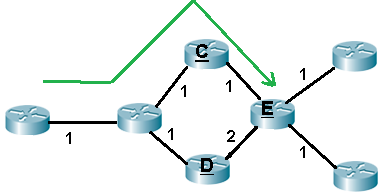I saw a network using MPLS, BGP and OSPF as main network protocols. I understand that BGP was used to exchange traffic with another AS, and OSPF was used as Internal Gateway Protocol. So, why to use also MPLS if we already had OSPF?
3 Answers
Why does MPLS need an IGP (like OSPF) in order to work?
In an MPLS network, OSPF is not used to route customer traffic. It is only used to provide routing for the internal provider network so that labels can be generated. LDP is used to advertise these labels to neighboring label-switched routers.
So, why to use also MPLS if we already had OSPF?
You're really asking how MPLS works. The answer to that is too long for this forum.
But briefly, OSPF is a poor choice for routing customer networks because
- Customer addresses can (and often do) overlap. If customer A and customer B both use the 10.0.0.0 network, it is necessary to keep them separate. OSPF can't do that.
- Customer networks need to be isolated. You don't want Customer A to see routes from Customer B. OSPF can't do that either.
- You can have hundreds of customers, each with thousands of routes. OSPF doesn't scale well to that size.
- You may want to route your customer traffic over a particular path. OSPF has a very simple routing metric that doesn't allow that kind of path manipulation.
-
Just to add some information, the use of MPLS, as far as I investigated, was motivated by cost and also speed. Label matches are less costly to make and can be achieved faster that IP lpm lookups. Now the advantages are more like the ones mentioned by Ron. Commented Jul 8, 2020 at 9:21
So, why to use also MPLS if we already had OSPF?
Downsides of IGP
Metric based: There will be a segment underutilized as you can see from the link cost. Traffic for the different networks attached for E will always take the same path. The bigger the network the more the impact.
Pattern unaware: Traffic patterns on the network are not taken into account when the IGP calcultes it's forwarding table. Networks have different custom needs which demand 'smarter' approaches.
Lack of control: All traffic goes over the IGP path, and if you change the metrics to adjust traffic over a different route, you have just moved the problem to another section of the network.
Benefits of MPLS
Faster: This is more as a historical fact as hardware and software have evolved greatly and will continue to do. MPLS was originally designed to make IP routers as fast as ATM switches for handling traffic.
Scalability: Service Providers can offer different technologies like ATM, Frame Relay, Ethernet and IPsec over the same infrastructure. Imagine the nightware of the operational costs involved in maintaining 4 different infrastructures.
Traffic Engineering: MPLS uses signaling protocols to distribute labels, and with RSVP you can have more control on the information that is accounted to route traffic and therefore have more efficient and satisfactory link utilization.
MPLS is used to tunnel traffic over MPLS core routers to reach BGP NHs of BGP destination networks, since these MPLS core routers probably didn't learn (and probably shouldn't learn) the destination NLRIs via BGP.
In case of L3VPN for example, without MPLS it would be necessary for all provider core routers to know all customer's routes via BGP, each in its own VRF to keep separation between all customers. So in that case, an addition of a new customer would require an update of all provider core routers as well. This solution is not very scalable and requires a lot of work to maintain.
Maybe some other tunneling mechanism could be deployed here, but MPLS based tunnels are easier to configure and are dynamic (based on LDP which is derived from IGP information).


